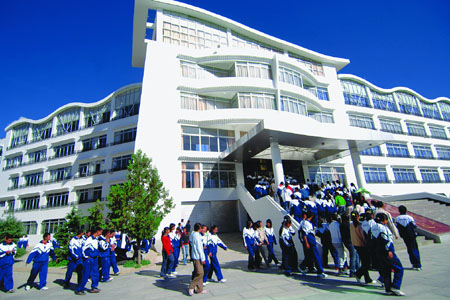| There wasn't even one formal school in the modern sense in all Tibet before liberation. The illiteracy rate reached 95 percent and the school enrollment rate only 2 percent. Through the efforts of more than 50 years, a comparatively integrated education system, including preschool education, elementary and secondary education, higher education, vocational education, special education and adult education, has been shaped.

The Lhasa Middle School, founded in 1956, is the first middle school set up in Tibet in history. Picture shows its new teaching building.
In 2006, Tibet invested more than 2 billion Yuan in the development of the education undertaking, an increase of 3.35 percent. By the end of 2006, there were 890 elementary schools, 1,568 teaching centers, with a total student body of 329,500 and an attendance rate of 96.5 percent for children of school age, a rise of 0.6 percentage point over 2005; there were 93 junior middle schools, with 127,900 students and an attendance rate of 75.4 percent; 13 senior middle schools, with 37,700 students; and 10 secondary vocational schools, with a total student number of 14,775. Now, there are six higher schools such as Tibet Nationalities Institute, Tibet Agriculture and Animal Husbandry College, Tibet University and Tibet Institute of Tibetan Medicines, with 23,327 students. Over 20,000 students have graduated from universities and more than 23,000 students from technical secondary schools, including a number of Tibetan doctors and masters. In addition, there are also large numbers of professional talents such as Tibetan scientists, engineers, professors, famous doctors, writers and artists.
Compulsory Education
Tibet steadily pushes forward the popularization of compulsory education. By the end of 2006, 73 counties had popularized six-year compulsory education, covering 2.5988 million people with the coverage rate reaching 99.4 percent; 49 counties had popularized nine-year compulsory education, covering 1.835 million people with the coverage rate reaching 70.5 percent. The coverage rate of the population becoming literate in 64 counties reached 90.4 percent. The illiteracy rate of young and middle-aged people was reduced from 39 percent in 2000 to below 10 percent in 2006.
From 1985, Tibet provided subsidies for the costs of food, accommodation and the education fees of students from the rural and pastoral families. In 2006, some 246,000 students of middle and elementary schools enjoyed an annual per capita subsidy of 1,100 Yuan. Of the total, the annual subsidy provided for children of the farmers and herders in the border counties and towns in Tibet was 1,200 Yuan for primary school pupils and 1,350 Yuan for students of junior high school. Even children of farmers and herders who failed to gain the subsidies had the chance to gain a stipend of 900 Yuan at most in every academic year. In 2006, Tibet paid out subsidies totaling some 280 million Yuan. In addition, Tibet also provided free teaching materials and workbooks for students during the compulsory education period in the rural and pastoral areas.
From the autumn in 2007, such subsidies will be raised again. Of the total, the annual per capita subsidy provided for primary school pupils from the rural and pastoral families will be increased to 1,200 Yuan from the original 1,100 Yuan and that for students of junior high schools will be raised to 1,350 Yuan from 1,250 Yuan; with regard to students in border counties and towns, it will be 1,300 Yuan for primary school pupils and 1,450 Yuan for junior high school students.
Teaching in Tibetan Language
Currently, besides elementary schools whose students are mainly of the Han ethnic group in a few cities and towns teaching in Chinese, most primary schools in rural and pastoral areas as well as the urban areas require courses to be taught in Tibetan. In the whole region, a total of 102 classes are taught in Tibetan language, as well as some courses in middle schools. Meanwhile, efforts are also being made to accelerate the teaching of natural science in the junior-middle-school phase in Tibetan.
From 1985, the State opened Tibetan classes and schools in some 20 provinces and cities in the hinterland successively, ranging from junior middle school to university. Tibetan Middle Schools in the hinterland have always had Tibetan courses. By the end of 2006, there were altogether 28 schools in the country running Tibetan classes, including 19 junior middle schools, seven senior high schools and two normal schools. A total of 53 inland senior high schools enrolled transfer students from Tibetan classes, and 90-plus higher schools admitted the senior high school graduates from Tibetan classes. The Tibetan classes of the junior high schools enrolled 33,100 students accumulatively, and some 14,300 graduates returned to Tibet for its construction.
With regard to Tibetan, the major subject and basic teaching language of the schools at various levels and of diverse kinds, efforts are made to improve the teaching contents and methods constantly and raise teaching quality. From 1989, Tibet University successively ran classes for training would-be Tibetan teachers of junior high schools. Up to now, it has trained 1,438 such teachers and compiled and rewritten the teaching materials of 19 disciplines. |





